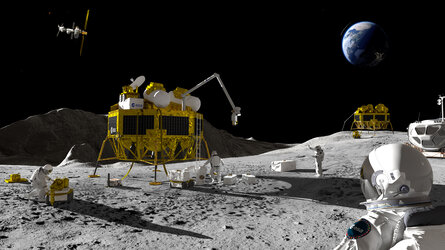Proba-1 payloads
Proba-1 carries onboard several Earth observation and space environment scientific instruments. In view of the project’s aim to demonstrate technology, several platform elements and systems have also been included as technology experiments.
The Proba-1 development approach includes several innovative aspects. A design-to-cost approach was adopted according to European Cooperation for Space Standardisation category 3 project classification. This involved using COTS (commercial off-the-shelf) equipment and units; simulation-based development, verification and testing; automated software generation; extensive use of test and operations infrastructure commonalities; and a highly integrated ESA-industry design and development team.
Extensive use is made of automated functions onboard the spacecraft. Full onboard flight dynamics computation, in conjunction with automated ground segment functions such as pass automation and high-level user interfaces, satisfy the spacecraft autonomy requirements.
Automated functions onboard handle nominal spacecraft operations, plan and schedule activities, and manage payload resources. Onboard flight dynamics include orbital navigation as well as computation and control of instruments, camera pointing and scanning in order to meet user-defined targets (latitude, longitude and altitude).
Technology payloads and innovative features
Autonomous star tracker:
This is the first time that an autonomous star tracker has been used as the only source of attitude on an Earth observation, agile spacecraft.

| Mass | 1.5 kg (electronics), 600 g (each camera head) |
|---|---|
| Power | 7.5 watt (including 2 heads) |
| Dimensions | 165x100x100 mm3 |
| Performance | 4-6 arcsec up to 1.2°/sec |
| Key characteristics | 2 camera heads |
| lost-in-space functionality | |
| reprogrammable software | |
| RS422 interface |
Avionics

Platform avionics:
- 1st SPARC in orbit on a satellite
- 50% load at 14 MHz for all onboard software functions (ACNS and data handling)
Payload avionics: PPU (Payload Processing Unit)
- DSP based TCS21020
- 1.2 Gbit mass memory based on 3D modules
- interface to all onboard cameras
- interface to SIPS and MRM
- processing unit for PASS star tracker
Software technology and development approach:
- COTS operating system (VxWorks) integrating software from several sources (C, Autocode)
- full auto-coding of all ACNS functions (attitude control and navigation)
- simulation-based development using SVF (Software Validation Facility)
Structure: fully commercial process
Li-Ion battery:
- 1st Li-Ion in LEO orbit
- capacity: 9 Ah
- mass: 1.9 kg
ACNS approach:
- full onboard flight dynamics
- gyroless attitude determination
- automatic large angle slews possibility, allowing several types of imaging (target pointing, BRDF, variable push broom)
- 2 Kalman Filters (10 and 6 states) at 6 Hz
- experimental GPS attitude determination
Ground segment automatic functions:
- spacecraft pass operations
- science data distribution
- spacecraft performance evaluation
- high-level user requests to spacecraft via Internet
Instruments

Compact High Resolution Imaging Spectrometer (CHRIS):
CHRIS is used to measure directional spectral reflectance of land areas, thus providing new biophysical and biochemical data, and information on land surfaces.
- multiple imaging of same target area under different viewing and illumination geometries
- spectral range: 415-1050 nm
- spectral resolution: 5-12 nm
- spatial resolution: 20 m at nadir
- swath width: 14 km
- up to 19 spectral bands simultaneously at full resolution
High Resolution Camera (HRC):

HRC is a black and white camera with a miniaturised Cassegrain telescope.
- Mass: 2.1 kg
- Aperture: 115 mm
- Focal length: 2296 mm
- Field of view: 0.504 deg
- CCD detector: 1024x1024 pixels
- Geometrical resolution: 5 m
Wide Angle Camera (WAC):
This miniaturised black-and-white camera is used for Earth observation, as well as for public relations and educational purposes.
- CMOS detector: 640x480 pixels
- Field of view: 40x31 degrees
Space Radiation Environment Monitor (SREM):

SREM is used to provide data on space weather and space environment.
- measurement of electron flux (0.3-6 MeV), proton flux (8-300 MeV) and total radiation dose
- three detectors
Debris In-orbit Evaluator (DEBIE):

DEBIE provides information on space debris in low-Earth, Sun-synchronous orbit.
- measurement of sub-mm meteroid and debris mass (>10-14g), speed and penetration power using impact ionisation, momentum and foil penetration detection
- two detectors on the spacecraft ram and deep-space faces
Smart Instrument Points (SIPs)
These are smart sensors used to measure total radiation doses and temperature around the spacecraft.
- Mass: <3g (each SIP)
Miniaturised Radiation Monitor (MRM)

The Miniaturised Radiation Monitor is an instrument that exploits a new method for measuring radiation based on quartz scintigraphy. This measurement method is evaluated on Proba by comparing MRM and SREM measurements.
The Proba-1 Attitude Star Sensor is a new development of autonomous star sensor. Proba-1 provides a flight demonstration for this unit and also the opportunity to test its novel star-pattern recognition algorithm.















 Germany
Germany
 Austria
Austria
 Belgium
Belgium
 Denmark
Denmark
 Spain
Spain
 Estonia
Estonia
 Finland
Finland
 France
France
 Greece
Greece
 Hungary
Hungary
 Ireland
Ireland
 Italy
Italy
 Luxembourg
Luxembourg
 Norway
Norway
 The Netherlands
The Netherlands
 Poland
Poland
 Portugal
Portugal
 Czechia
Czechia
 Romania
Romania
 United Kingdom
United Kingdom
 Slovenia
Slovenia
 Sweden
Sweden
 Switzerland
Switzerland




























